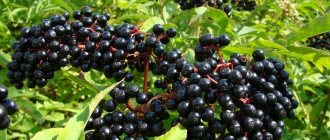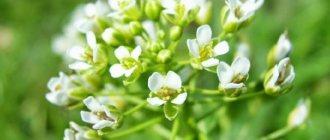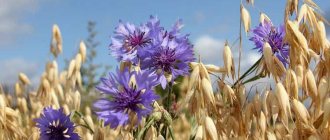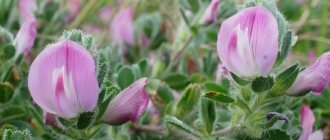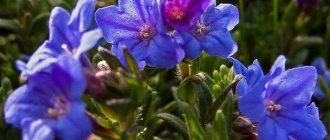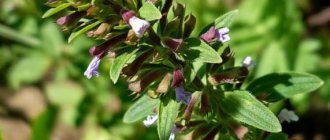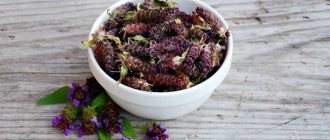Website about traditional medicine
- Description and distribution
- Properties and Application
Despite the fact that the wildflower plant (anagallis) is very beautiful and useful, when collecting raw materials you should act with caution, since all its parts, especially the roots and seeds, are poisonous.
For therapeutic purposes, decoctions, powders, enema solutions and compresses based on this medicinal herb are used. When preparing medications, it is important to strictly adhere to the dosage. Description of the full-colored polewort (Anagallis arvensis L.): belongs to the Primulaceae family, is an annual low plant, 10-15 cm high, with several stems (less often one) and a thin tap root; the stem is prostrate or ascending, the leaves are opposite, sessile, ovate, green above, with black dots below.
The flowers are solitary, sessile in the leaf axils on elongated pedicels, 10-15 mm in diameter. They open only for 7-14 hours. However, the plant as a whole blooms for up to 1.5 months.
Flowers from central Europe are brick red or bright red and are rarely blue. The flowers of plants from the Mediterranean are larger and usually blue. The fruits are boxes with an opening lid, the stalk of which is always directed towards the ground.
The seeds are brown and dispersed by the wind. Blooms in June-July. Fruits in August-October.
Economic importance and application
Ornamental plant. Garden forms available (hybrid Anagallis ×grandiflora
).
Wildflower is a plant with bright red flowers, less often blue; as a weed, it is found everywhere in European fields. It was considered for some time an effective remedy for rabies, about which there were many medical articles. Also used for melancholy, epilepsy and cancer in the form of a dried herb called Herba Anagallidis
. It is considered poisonous due to the presence of anagallis saponin[3].
Botanical description
An annual herbaceous plant, creeping or climbing. All parts of the plant, especially the roots, are poisonous because they contain saponins. Stems are 5-30 cm long. Leaves are opposite, sessile, entire.
Flowering from May to October. The flowers are arranged singly in the leaf axils. The flowers are radially symmetrical, reaching 10-15 mm in diameter. They are only open from 7 am to 2 pm.
The anthers are pubescent and attract a variety of insect pollinators (entomophily), especially flies. Sometimes, however, spontaneous self-pollination occurs.
The flowers of plants from Central Europe are usually bright red and rarely blue. Plants from the Mediterranean region have slightly larger flowers, usually blue.
The fruits are capsules and ripen from August to October. The stalks are directed towards the ground, so the brown seeds spilling out of the pods are spread by the wind (anemochory).
Anagallis, or wildflower, is an annual or biennial herbaceous plant up to 30 cm tall, with delicate tetrahedral, slightly winged, simple or branched, prostrate and erect stems. The leaves are opposite, sometimes arranged in groups of three, ovate or oblong-ovate, small, 0.8-2 cm long and 0.3-1 cm wide, obtuse at the apex, entire at the edge, slightly deflected, bright green, with black dots.
The flowers are located singly in the axils of the leaves on pedicels 1.5-2 times larger than the leaves, sometimes equal to them. When the fruits ripen, the pedicels bend downwards. The calyx is 3.5 mm long, with lanceolate or lanceolate-linear, acute, membranous lobes along the edge. The corolla is reddish, blood-red or orange-red, wheel-shaped, 0.5 cm in diameter, with a five-part limb almost to the base, its lobes are ovoid, obtuse, with finely glandular-ciliated edges.
The flower petals are surrounded by 5 stamens, each of which is equipped with purple hairs that serve to attract insects (the flowers have no smell or nectar). However, pollinators cannot be fooled, and only flies fall for this trick. The fruit is a multi-seeded spherical capsule 3.5-4 mm in diameter, membranous, cracking across - as if its lid is opening. The seeds are dark brown, triangular, small, up to 0.8 mm.
On fine days, the flowers open at 8-9 and close until 15 o'clock, and in inclement weather they quickly fold. For this feature, Anagallis arvensis acquired the English names Shepherd's clock, Poorman's barometer, etc.
There are several natural varieties:
- Anagallisarvensis ssp. arvensis – more common, flowers correspond to the description given above;
- Anagallis arvensiscaerulea (syn. Anagallisarvensis ssp. arvensis f. azurea) - rarer in nature, but grown more often, distinguished by the bright blue color of the flowers, blooms earlier than the red form;
- Anagallisarvensis var. carnea – peach-colored flowers;
- Anagallis arvensis var. lilacina – lilac flowers;
- Anagallis arvensis var. pallida is a low-growing plant with white flowers.
The blue form is most common on the southern coast of Spain, while in the rest of Europe only the red form is found. The common name of the plant in Spain is jabonera (“soap grass”), indicating the high content of saponins that form “soap foam” in water.
To be fair, the true color blue is occasionally found in both the UK and Central Europe. It began to appear in Pakistan and India, but it is indicated that in Pakistan the blue color of the flowers disappears over time and is replaced by white and pink. Specimens with multi-colored flowers are found sporadically in nature.
At one time, the Briton Henslow discovered that the offspring of the blue form contained both red and blue plants. And Darwin, cross-pollinating the red and blue forms, received red, blue and some intermediate colors. Botanist Gerard suggested that the red form represents a male plant, and the blue form a female. But this one is not so, since the flowers of the plant are known to be self-pollinating.
34 species of herbaceous plants make up the genus Anagallis from the Primrose family. Annuals and perennials grow in Eurasia, America, Africa in meadows, along the banks of reservoirs, and in rocky areas.
Anagallis has a thin tap root. The stem is tetrahedral, prostrate, sometimes ascending, up to 30 cm long. The shoot branches strongly, forming impressive mats.
Leaves are opposite, small. The leaf blades are glossy, bright or dark green, ovoid in shape.
Flowering begins in spring. Flowers on thin stalks appear in the axils of the leaves. The color of numerous five-petaled flowers can be bright red, white, orange, and blue. The stamens with large yellow anthers are clearly visible. The buds appear one after another, providing a long-lasting decorative effect until frost arrives.
Anagallis is not only a beautiful plant, but also has healing properties. Once upon a time they even tried to treat rabies. Although the attempts were unsuccessful, decoctions and tinctures found worthy uses. They help with diseases of the kidneys, liver, and lungs. Heal wounds and have a calming effect.
Growing
Anagallis can be grown outdoors and in containers. It is also suitable for hanging baskets. The plant is perfect for rockeries.
Although most Anagallis are perennials, in culture, especially when grown outdoors, they are recommended to be used as annuals.
Anagallis is not picky and is content with minimal attention from its owners.
As a rule, the procedure is carried out in the spring. Since the delicate root system requires careful treatment, it is better to transship it.
Anagallis is considered a weed in agriculture. To prevent excessive propagation by self-sowing, faded flowers should be removed before fruit formation.
In culture, Anagallis can be propagated by cuttings. They are harvested in the fall, placed in a substrate and kept at above-zero temperatures until spring. With the arrival of warmth, they are transplanted to a designated place.
Reproduction
Seeds, cuttings, dividing the bush.
Anagallis is grown from seeds. With both methods (seedlings and non-seedlings), germination is about 50%.
Sowing of seedlings is carried out in April. The seeds are placed in a container filled with a nutrient substrate with the addition of peat. They are sprinkled with a thin layer of perlite on top and covered with polyethylene or glass. Daily ventilation is required.
Seeds are sown in open ground in May. In this case, flowering occurs somewhat later, usually in mid-July.
Secrets of success
Anagallis loves bright light. But at the same time it needs protection from direct sunlight. Shading is especially important when growing in pots.
From spring to autumn, the plant should be watered regularly, avoiding waterlogging of the soil and accumulation of water in the ground. In hot summers, the intervals between waterings are reduced.
When kept indoors, it is necessary to provide access to fresh air by periodically ventilating the room. Do not forget that drafts have a negative effect on the plant.
Anagallis is not picky about air temperatures. The plant is fed with complex mineral fertilizers twice a season: the first time before planting in May, the second time in August.
Caring for Anagallis includes weeding and loosening the soil.
Possible difficulties
Without detracting from the medicinal properties of Anagallis, it must be remembered that the plant contains substances that are dangerous to poultry and animals. No wonder it has another name - kuroslep or kuromor.
Anagallis suffers from excessive watering. The first signal is yellowing of the leaves. Stopping watering for 2-3 weeks can correct the situation.
Direct sunlight “burns” tender leaves. In bright light, you must urgently move the pot to another place.
When growing Anagallis, do not forget that in cloudy weather the flowers refuse to open.
Medicinal plants: wildflower
Hidden under the name wildflower is a well-known plant - night blindness.
What does the actual color look like?
Wildflower (Anagallis arvensis L.) is an annual medicinal herb with many creeping, tetrahedral, branched stems. Belongs to the primrose family. The length of the stems is up to 30 cm. The leaves of the plant are sparse, opposite, grouped in groups of three in a whorl. The flowers are beautiful, solitary, bright red, with a glandular-ciliated corolla along the edge. The fruit is a ball-shaped capsule with many small black seeds. The flowering of the plant can be observed in May - September.
Where does wildflower grow?
The medicinal plant wildflower can be found in the Caucasus, Central Asia, Belarus and Ukraine, in Russia. Full-colored field weeds can be seen in gardens and crops, on foothill plains, along mountain slopes, and in meadows.
Full-time color field photo.
Preparation of full-color field flowers.
For the preparation of medicines, the juice of a fresh plant and full-colored grass (flowers, leaves, stems) are used. The collection of raw materials is carried out in May - August.
Chemical composition of wildflower.
The roots and grass of the plant contain a peptonizing enzyme, saponins and 2 glycosides equivalent to soapwort sapotoxin and polygallic acid. Ferulic, sinapic, caffeic and other acids, kaempferol, quercetin, fatty oil and anthocyanins, and poisonous cyclamine were found in the roots.
Medicinal properties of wildflower.
The medicinal plant has analgesic, sedative, anti-inflammatory, antitoxic, wound-healing, diuretic and diaphoretic effects.
Application of full-time wildflower.
Although healers do not praise such medicinal plants as field flowers on every corner, realizing that self-medication with them can be dangerous, nevertheless, traditional medicine in many countries uses the plant for diseases of the gallbladder, liver, bronchitis, with difficult to remove sputum, and for kidney problems. - stone disease, epilepsy, pulmonary tuberculosis, mental illness.
The color is quite widely used for skin diseases (dermatoses with itchy skin, lichen), nervous diseases, cholecystitis, nephritis, hepatitis.
The crushed raw materials of the plant are used to sprinkle on animal bites and long-healing wounds.
The herb is used in the form of poultices for diathesis rashes and myositis.
Fresh juice with honey is used for eye diseases, incl. with cataracts.
Infusion of full-blown wildflower.
Pour 200 ml of boiling water over half a teaspoon of dry crushed plant herbs, leave for 10 minutes, and peel through cheesecloth. Use 2 tbsp. l. 3 - 4 r. in a day.
Poultices with wildflowers.
3 - 4 tbsp. l. Pour boiling water over the herbs and wrap them in a bandage or gauze. Use hot pads to relieve inflammation and relieve pain.
Field flower for cataracts.
For cataracts, combine the juice of the plant with honey in equal quantities and 2 - 3 r. Apply 2-3 drops of the resulting product per eye per day. If you experience discomfort, dilute the composition with boiled water.
Contraindications for full-time wildflower.
Due to the toxicity of the plant, use its preparations very carefully, consult a doctor before use!
Contraindications for full-time wildflower:
The internal use of wildflower, as a poisonous plant, requires caution.
In case of poisoning with wildflower preparations due to an overdose when used internally, acute lesions of the gastrointestinal tract occur, causing diarrhea, nausea and vomiting. Long-term use harms the kidneys. Undesirable effects on the nervous system were also observed. People allergic to primroses may develop a skin rash.
If this happens, it is necessary to lavage the stomach with an aqueous suspension of activated carbon, prescribe saline laxatives, and high enemas. Mucous decoctions and fresh egg whites are recommended. Further treatment is symptomatic.
Composition and properties
The herb contains: tannins, saponins, flavonoids, glycosides, anthocyanins, fatty oil, phenolcarbolic acids. Wildflower has anti-inflammatory, blood-purifying, sedative, analgesic, wound-healing, laxative, restorative, diaphoretic, bile- and diuretic effects. In folk medicine and homeopathy, wildflower is used for:
- colds, coughs;
- pulmonary tuberculosis;
- nervous and mental disorders;
- epilepsy;
- jaundice;
- diseases of the kidneys, liver, gall bladder;
- stones and sand in the kidneys, urinary and gall bladders;
- hernia;
- dropsy;
- dysentery;
- constipation;
- menstrual disorders and other women's diseases;
- oncology;
- aching joints;
- bleeding;
- cataracts, cataracts and other eye diseases;
- non-healing wounds, lichen, diathesis, scrofula, skin rash.
- 20 g of chopped dry herb;
- 1 liter of boiling water.
Pour boiling water over the herb, cover the container with the mixture with something warm and leave to steep for half an hour. Strain. Drink 1-2 glasses of infusion per day for diseases of the liver, kidneys, bladder, gall bladder, and depression. This infusion can also increase menstruation. For chronic constipation, this infusion can be used for enemas.
Fresh herb infusion:
- 1/2 tsp. fresh, full-colored grass;
- 1 tbsp. boiling water
Grind the herb, pour boiling water over it and let it brew under the lid for 10 minutes. Strain the resulting infusion. Take 2 tablespoons 3-4 times a day. Decoction:
- 1 tbsp. fresh chopped full-colored herbs;
- 2 tbsp. boiling water
Pour boiling water over the herb and cook in a water bath, covered, for 10 minutes. Strain. Drink half a glass 2-3 times a day after meals. This decoction can also be used for douching for diseases of the female organs - to do this, add 4-6 glasses of boiled water to the prepared decoction and use the entire volume of the resulting liquid during the procedure.
Dysentery decoction:
- a bunch of grass in the full color of the field;
- 1 liter of hot water.
Pour water over the herb and boil for 10-15 minutes over low heat. Strain the resulting broth. Drink 50 ml in the morning for 2-3 days. For cataracts:
- 1 part fresh plant juice;
- 1 part honey.
Mix wildflower juice with honey in equal parts and drop 2-3 drops into the eye 2-3 times a day. If you experience discomfort in your eyes, dilute the product with boiled water.
As noted above, all parts of the plant, especially the roots, are poisonous. The plant contains two glycosides, tannins, proteolytic enzymes and pungent essential oils. It is poisonous because it contains a lot of saponins.
Symptoms of poisoning: excessive diuresis (urination), trembling, pasty and watery stools, disorders in the nervous system, spinal cord and brain, inflammation of the digestive tract.
It causes gastroenteritis in dogs and horses, and wildflower is also poisonous to poultry and rabbits. Essential oils cause headaches and nausea.
The leaves can cause an allergic skin reaction - dermatitis.
Recipes
Infusion:
- 20 g of chopped dry herb;
- 1 liter of boiling water.
Pour boiling water over the herb, cover the container with the mixture with something warm and leave to steep for half an hour. Strain. Drink 1-2 glasses of infusion per day for diseases of the liver, kidneys, bladder, gall bladder, and depression. This infusion can also increase menstruation. For chronic constipation, this infusion can be used for enemas.
Fresh herb infusion:
- 1/2 tsp. fresh, full-colored grass;
- 1 tbsp. boiling water
Grind the herb, pour boiling water over it and let it brew under the lid for 10 minutes. Strain the resulting infusion. Take 2 tablespoons 3-4 times a day. Decoction:
- 1 tbsp. fresh chopped full-colored herbs;
- 2 tbsp. boiling water
Pour boiling water over the herb and cook in a water bath, covered, for 10 minutes. Strain. Drink half a glass 2-3 times a day after meals. This decoction can also be used for douching for diseases of the female organs - to do this, add 4-6 glasses of boiled water to the prepared decoction and use the entire volume of the resulting liquid during the procedure.
Dysentery decoction:
- a bunch of grass in the full color of the field;
- 1 liter of hot water.
Pour water over the herb and boil for 10-15 minutes over low heat. Strain the resulting broth. Drink 50 ml in the morning for 2-3 days. For cataracts:
- 1 part fresh plant juice;
- 1 part honey.
Mix wildflower juice with honey in equal parts and drop 2-3 drops into the eye 2-3 times a day. If you experience discomfort in your eyes, dilute the product with boiled water.
Wounds that do not heal for a long time are sprinkled with powder from dry grass of the same color. The juice of the fresh plant is used to prepare eye lotions for cataracts, cataracts (in the initial stages of development) and other diseases. Poultices are made from fresh or dry herbs for aching joints, colds, scrofula: take 2-3 tablespoons of the herb, wrap in gauze, pour boiling water for 1-2 minutes, squeeze out excess moisture and apply to the sore spot.
Contraindications
Attention! – wildflower is a poisonous plant. Its seeds are especially dangerous. The use of full-time color is strictly contraindicated:
- children;
- pregnant and lactating women;
- with individual intolerance.
Excessive use of drugs prepared on the basis of intravenous color can lead to the following side effects: nausea, vomiting, dizziness, headache, stool upset, skin rash, excessive urination, trembling, nervous system disorders, kidney disease.
Anagallis species
Two types are used in gardens:
Anagallis blue (Anagallis foemina, syn. Anagallis caerulea) or Full color blue looks very impressive. Its flowers surprise with their intense sapphire color. The diameter of the flowers is about 8 mm. The blue flowers close at night and in cloudy weather. This variety is often used to decorate flower beds, hanging baskets and planted in containers.
Anagallis arvensis - distributed almost everywhere, grows as a wild plant among shrubs and meadows. Blooms from May until autumn frosts. The flowers are small, diameter 5-8mm. In bad weather they close, folding their petals tightly. These are very unpretentious plants; they grow where other flowers cannot grow. They are used to frame paths, steps, and are sown to fill empty spaces in flower beds.
There are garden forms of anagallis (hybrid Anagallis ×grandiflora or Anagallis monellii), their flowers are larger, they reach 2.5 cm in diameter, the bush is more compact. This is a perennial plant, but in frosty winters it freezes out; we use it as an annual.
Wildflower is considered a poisonous plant due to the presence of saponin.
In culture[edit | edit code]
In 1905, Baroness Emma Orzi wrote the classic adventure novel Scarlet Pimpernel (English: Scarlet Pimpernel). In 1934, a film of the same name was made based on the novel.
Anagallis, or wildflower, is one of those plants that grow in Russia, but are rare. In different Russian regions it acquired the popular names night blindness, chicken glasses, scratch help. The latter, of course, indicates its medicinal properties, which were once highly valued.
But, as often happens, wildflower came to our gardens from Europe, where it has long been cultivated as a medicinal and ornamental plant. Since the 16th century it has been referred to as Bipinella. They had their freckles removed and treated for rabies and melancholy. Pliny spoke of its value in liver complaints.
And the genus name Anagallis is derived from the Greek Anagelao, meaning “to laugh.” Dioscorides, who gave this name, believed that the plant eliminates depression that follows liver disease. But now the plant is treated with great caution due to the content of poisonous saponins and cytotoxic cucurbitacins.
The wildflower (Anagallis arvensis) is just one of 34 members of the genus that is part of the primrose family (Primulaceae). Its range is extensive: the European part of the former USSR, Central Asia, Western Europe, the Mediterranean, Asia Minor, India. Distributed in Africa, Australia and the American continent - everywhere except the tropics.
Types of anagallis with photos and names
Anagallis grandiflora Anagallis grandiflora
Anagallis grandiflora photo
The ancestor of most garden forms. Plants with orange flowers are common in Morocco and Southern Italy, and blue ones in Southern Spain. There are white-flowered varieties, and red varieties have been bred. In our country, the varieties on sale are mainly Charming, Blue Sea, Sineglazka and simply the seeds of a species plant.
Anagallis arvensis or blue, blue Anagallis arvensis
Anagallis arvensis photo
Bushes with shoots 15 cm long. Flowers of various shades of blue. Varietal plants have red flowers; this subspecies is also called scarlet primrose.
Anagallis Monelli Anagallis Monelli
Anagallis Monelli Anagallis Monelli photo
Originally from the Mediterranean. In appearance it is similar to large-flowered: the stems are 20 cm long, the corollas are 2.5 cm in diameter, their shade is predominantly blue. Most popular in the West. The hybrid variety Wildcat Mandarin is in particular demand. Captivates with its clean and bright orange-red corollas. It was created and patented by breeders from the University of New Hampshire (USA, New England). It is grown as an annual, although it is perennial. The characteristics indicate that the shoots are 30 cm long, but in reality they are no more than 15 cm. There are a lot of flowers, withered corollas do not have to be removed for new ones to appear. Blooms non-stop.
Anagallis tender or tenella Anagallis tenella
Anagallis Tenella Anagallis tenella photo
It is not cultivated here, although it is promising for wet areas; in Britain it is called swamp primrose. The color of the corollas is pastel pink.
Anagallis arvensis (Anagallis arvensis) is the most common species. In the wild it is found everywhere: in North and West Africa, Europe, and Oceania. In many countries it is recognized as a weed, but serves as an indicator of light, loose soil. This archaeophyte plant is remembered in archaeological finds from prehistoric times.
Anagallis (Anagallis) - description, cultivation, photo
Reproduction
Location. Anagallis arvensis is a native, including our latitudes, it is quite cold-resistant in our climate, but loves the sun, like a southerner. Only in the middle of the day is some shading useful, since the plant is tender and does not tolerate drought and lack of moisture.
The soil. Anagallis loves soils containing sand and lime. Grows well in the acidity range pH 6.0-7.8. The soil should be loose, light, and drained - the soil does not tolerate stagnation of water. You should not strive for high soil fertility; anagallis prefers moderately rich ones. It is better to prepare a place for the plant in the fall, adding dolomite flour during digging to deoxidize the soil.
Watering is necessary regularly, but not excessively. Drought should also not be allowed.
Care. Weeding plants should be done carefully and preferably with gloves, because... contact with the skin can cause dermatitis.
Growing
Location . Anagallis arvensis is a native, including our latitudes, it is quite cold-resistant in our climate, but loves the sun, like a southerner. Only in the middle of the day is some shading useful, since the plant is tender and does not tolerate drought and lack of moisture.
The soil . Anagallis loves soils containing sand and lime. Grows well in the acidity range pH 6.0-7.8. The soil should be loose, light, and drained - the soil does not tolerate stagnation of water. You should not strive for high soil fertility; anagallis prefers moderately rich ones. It is better to prepare a place for the plant in the fall, adding dolomite flour during digging to deoxidize the soil.
Watering is necessary regularly, but not excessively. Drought should also not be allowed.
Care . Weeding plants should be done carefully and preferably with gloves, because... contact with the skin can cause dermatitis.
Anagallis, or wildflower Scarlet
Reproduction
Full flower is grown as an annual plant and propagated by seeds through seedlings. Small seeds of the plant are sown in early spring, at the beginning of April, to a depth of the size of the seed, i.e. only lightly covering with soil. Shoots usually appear after 1-1.5 weeks. If this does not happen, the tray with the crops is placed in the refrigerator for a period of at least 4 weeks to undergo stratification (the seeds of the plant are in deep dormancy, which cold treatment helps to interrupt).
It has been established that seeds ripened in a warm climate, at a temperature of 25... 30 o C, germinate easily, but seeds collected in a temperate zone germinate more difficult.
At the end of May - beginning of June, seedlings are planted in open ground at a distance of 40-50 cm. And at the end of June - beginning of July, the plants will be ready to flower. Anagallis blooms for a long time, until the end of August.
Features of the chemical composition
As noted above, all parts of the plant, especially the roots, are poisonous. The plant contains two glycosides, tannins, proteolytic enzymes and pungent essential oils. It is poisonous because it contains a lot of saponins.
Symptoms of poisoning: excessive diuresis (urination), trembling, pasty and watery stools, disorders in the nervous system, spinal cord and brain, inflammation of the digestive tract.
It causes gastroenteritis in dogs and horses, and wildflower is also poisonous to poultry and rabbits. Essential oils cause headaches and nausea.
The leaves can cause an allergic skin reaction - dermatitis.

